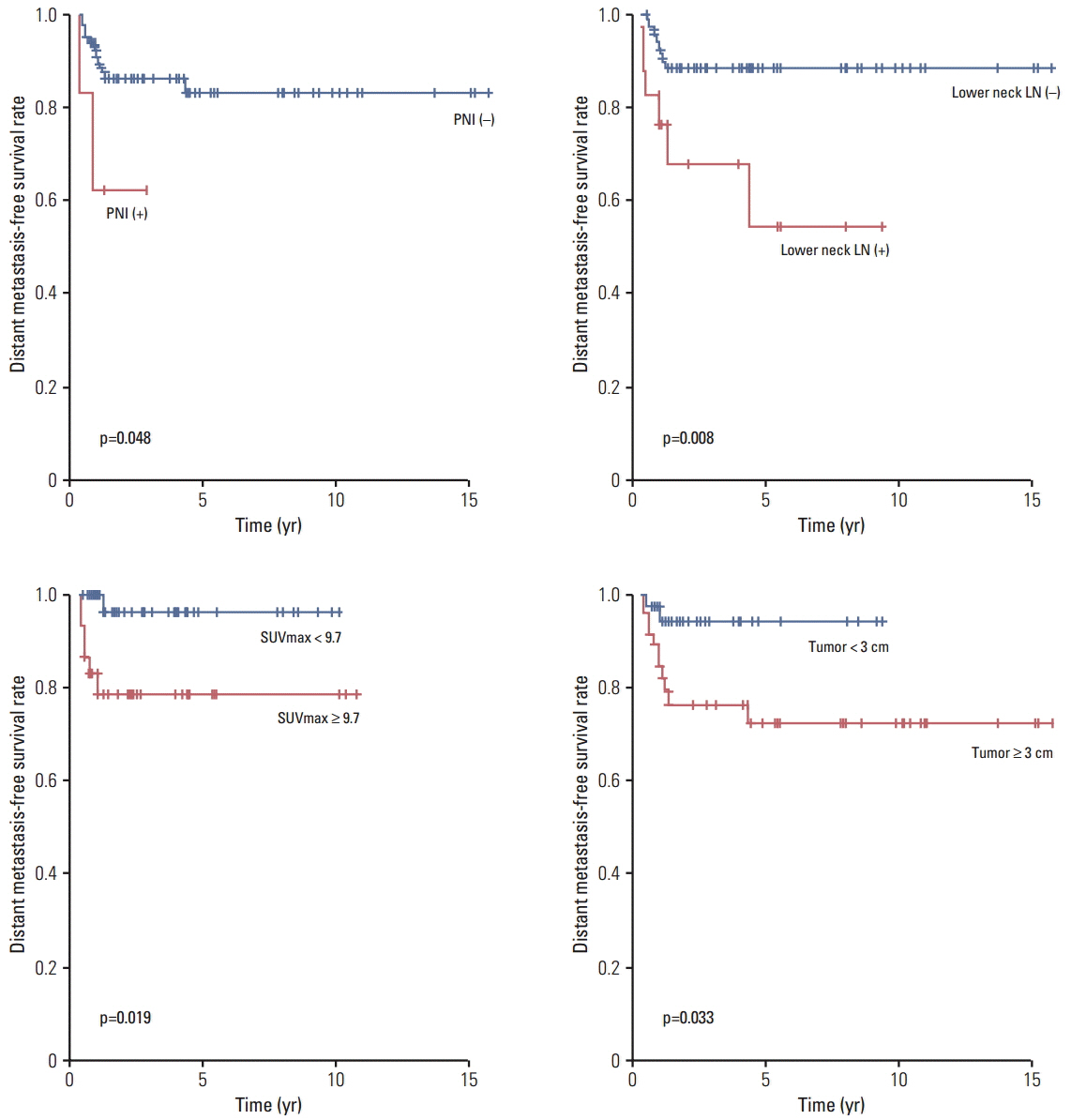Cancer Res Treat.
2016 Oct;48(4):1167-1176. 10.4143/crt.2015.379.
Predictors of Distant Metastasis after Radical Surgery Followed by Postoperative Radiotherapy with or without Chemotherapy for Oropharyngeal Cancer
- Affiliations
-
- 1Department of Radiation Oncology, Kyung Hee University Hospital at Gangdong, Seoul, Korea.
- 2Department of Radiation Oncology, Seoul St. Mary’s Hospital, College of Medicine, The Catholic University of Korea, Seoul, Korea. yeonkim7@catholic.ac.kr
- 3Department of Medical Oncology, Seoul St. Mary’s Hospital, College of Medicine, The Catholic University of Korea, Seoul, Korea.
- 4Department of Nuclear Medicine, Seoul St. Mary’s Hospital, College of Medicine, The Catholic University of Korea, Seoul, Korea.
- 5Department of Hospital Pathology, Seoul St. Mary’s Hospital, College of Medicine, The Catholic University of Korea, Seoul, Korea.
- KMID: 2356219
- DOI: http://doi.org/10.4143/crt.2015.379
Abstract
- PURPOSE
We investigated the prognostic factors for distant metastasis (DM) in patients with locally advanced oropharyngeal cancer (OPC) treated with surgery and adjuvant radiotherapy with or without concurrent chemotherapy.
MATERIALS AND METHODS
Eighty-five patients treated between January 1995 and August 2014 were evaluated retrospectively. Data regarding the pathological tumour and nodal status, human papillomavirus (HPV) status, treatment characteristics, and pretreatment maximum standardized uptake value (SUVmax) of 18-fluoro-2-deoxyglucose positron emission tomography-computed tomography scan (¹â¸F-FDG PET-CT) were evaluated, and their influence on DM and survival outcomes were analyzed.
RESULTS
Median follow-up period was 48.0 months. Recurrence was observed in 20 patients, including locoregional recurrence and DM. DM was observed in 13 patients. A multivariate analysis confirmed that the presence of lymphovascular invasion (p=0.031), lower neck lymph node (LN) involvement (p=0.006), SUVmax ≥ 9.7 (p=0.014), and tumour size ≥ 3 cm (p=0.037) significantly affected DM. HPV status was not associated with DM. Perineural invasion (p=0.048), lower neck LNinvolvement (p=0.008), SUVmax ≥ 9.7 (p=0.019), and tumour size ≥ 3 cm (p=0.033) were also significant factors for the DM-free survival rate.
CONCLUSION
Lower neck LN involvement, high SUVmax in pretreatment ¹â¸F-FDG PET-CT, and large tumour size were predictive factors for DM in patients of OPC.
Keyword
MeSH Terms
Figure
Reference
-
References
1. Shin A, Jung YS, Jung KW, Kim K, Ryu J, Won YJ, et al. Trends of human papillomavirus-related head and neck cancers in Korea: national cancer registry data. Laryngoscope. 2013; 123:E30–7.
Article2. Bernier J, Cooper JS, Pajak TF, van Glabbeke M, Bourhis J, Forastiere A, et al. Defining risk levels in locally advanced head and neck cancers: a comparative analysis of concurrent postoperative radiation plus chemotherapy trials of the EORTC (#22931) and RTOG (#9501). Head Neck. 2005; 27:843–50.3. Shang J, Gu J, Han Q, Xu Y, Yu X, Wang K. Chemoradiotherapy is superior to radiotherapy alone after surgery in advanced squamous cell carcinoma of the head and neck: a systematic review and meta-analysis. Int J Clin Exp Med. 2014; 7:2478–87.4. Cohen EE, Karrison TG, Kocherginsky M, Mueller J, Egan R, Huang CH, et al. Phase III randomized trial of induction chemotherapy in patients with N2 or N3 locally advanced head and neck cancer. J Clin Oncol. 2014; 32:2735–43.
Article5. Krishnatry R, Gupta T, Murthy V, Ghosh-Laskar S, Budrukkar A, Chaturvedi P, et al. Factors predicting 'time to distant metastasis' in radically treated head and neck cancer. Indian J Cancer. 2014; 51:231–5.
Article6. Li X, Di B, Shang Y, Zhou Y, Cheng J, He Z. Clinicopathologic risk factors for distant metastases from head and neck squamous cell carcinomas. Eur J Surg Oncol. 2009; 35:1348–53.
Article7. Ono I, Ebihara S, Saito H, Yoshizumi T. Correlation between prognosis and degree of lymph node involvement in carcinoma of the head and neck. Auris Nasus Larynx. 1985; 12 Suppl 2:S85–9.
Article8. Kim DH, Kim WT, Lee JH, Ki YK, Nam JH, Lee BJ, et al. Analysis of the prognostic factors for distant metastasis after induction chemotherapy followed by concurrent chemoradiotherapy for head and neck cancer. Cancer Res Treat. 2015; 47:46–54.
Article9. Suzuki H, Kato K, Fujimoto Y, Itoh Y, Hiramatsu M, Maruo T, et al. 18F-FDG-PET/CT predicts survival in hypopharyngeal squamous cell carcinoma. Ann Nucl Med. 2013; 27:297–302.
Article10. Xie P, Li M, Zhao H, Sun X, Fu Z, Yu J. 18F-FDG PET or PET-CT to evaluate prognosis for head and neck cancer: a meta-analysis. J Cancer Res Clin Oncol. 2011; 137:1085–93.
Article11. Kim G, Kim YS, Han EJ, Yoo IR, Song JH, Lee SN, et al. FDG-PET/CT as prognostic factor and surveillance tool for postoperative radiation recurrence in locally advanced head and neck cancer. Radiat Oncol J. 2011; 29:243–51.
Article12. Ang KK, Harris J, Wheeler R, Weber R, Rosenthal DI, Nguyen-Tan PF, et al. Human papillomavirus and survival of patients with oropharyngeal cancer. N Engl J Med. 2010; 363:24–35.
Article13. Joo YH, Cho KJ, Park JO, Nam IC, Kim CS, Kim MS. High-risk human papillomavirus and lymph node size in patients with single node metastasis of oral and oropharyngeal cancer. Acta Otolaryngol. 2014; 134:395–400.
Article14. Ko Y, Abel J, Harth V, Brode P, Antony C, Donat S, et al. Association of CYP1B1 codon 432 mutant allele in head and neck squamous cell cancer is reflected by somatic mutations of p53 in tumor tissue. Cancer Res. 2001; 61:4398–404.15. Gillison ML, Koch WM, Capone RB, Spafford M, Westra WH, Wu L, et al. Evidence for a causal association between human papillomavirus and a subset of head and neck cancers. J Natl Cancer Inst. 2000; 92:709–20.
Article
- Full Text Links
- Actions
-
Cited
- CITED
-
- Close
- Share
- Similar articles
-
- Combined Multimodality Treatment including Surgery
- The Efficacy of Postoperative Chemotherapy for Patients with Metastatic Brain Tumors from Non-Small Cell Lung Cancer
- Postoperative adjuvant MVP Chemotherapy and Radiotherapy for Non-Small Cell Lung Cancer
- The ideal strategies of chemotherapy for the treatment of cervical cancer
- Adjuvant Radiotherapy Following Radical Hysterectomy and Bilateral Pelvic Lymph Node Dissection for the Uterine Cervical Cancer: Prognostic Factors and Failure Patterns


